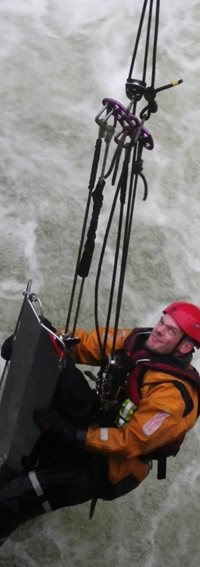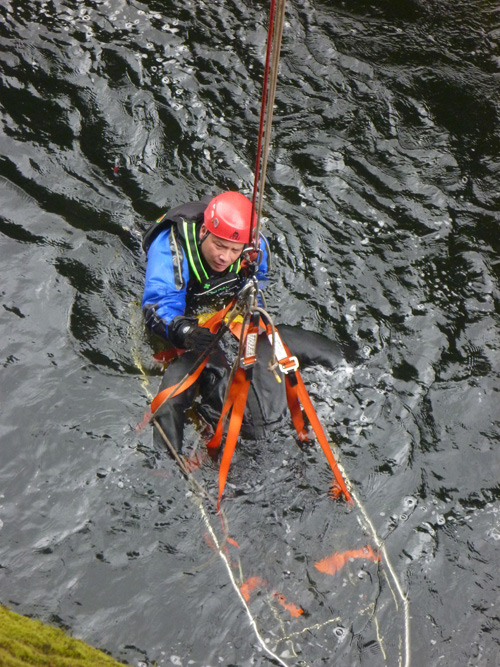 Looking happy enough, a member of Dorset Fire and Rescue Service descending with a seat stretcher, useful for rapid extrications from these challenging circumstances.
Looking happy enough, a member of Dorset Fire and Rescue Service descending with a seat stretcher, useful for rapid extrications from these challenging circumstances.
Working on rope rescue systems over water can be very problematic, with multiple risks and limited guidance, then again… it can make for a soft landing!
So what is the difference between this type of rigging and any other? Well, whilst the operator is at height, very little. Clearly they will require a standard work positioning set-up with the normal system redundancy. However, on nearing the water a new set of risks take over.
The only specific guidance here in the UK is that provided by the Fire Service Rope manual (P69) which specifies the need for a support system which can be released (one handed, under load) by the user. The idea is that in the event of becoming trapped in current the operator can easily escape the system and engage in a free swim to safety, adopting the same releasability ethos as all 'in water' rescue systems.
To this end we have always used the Act-Safe 'quick-out' karabiner which fits the criteria and is in widespread use for all related functions, (we were lucky enough to be trained in its use by the inventor Peter Sundermann who also made some adaptations for us).
Beyond this we have altered no other element of the required rigging for this environment, the rest being entirely compatible with standard rope rescue.
The students use a 'quick-out' karabiner in conjunction with an auto-locked pulley system. This is backed up by another adjustable connector. Whilst initially finding it to be a bit of an ugly tangle, students warm to it as rescue tasks in the water become more challenging and its versatility becomes more apparent. With this system in place, users are encouraged to call a halt to proceedings as water level is reached (at foot level) and unclip the safety back-up system so that nothing will hinder potential deployment of the 'quick-out'. With a well rigged attendant pulley system the rescuer can closely control their final descent into the water or shorten the rig to avoid trouble in the event of having been lowered too far.
As with normal rope rescue, the provision of adjustable attendant attachments allows their position to be altered in relation to that of a casualty rescue strop or stretcher system. This is particularly useful in an environment where casualty handling is fraught with difficulty. Students find the challenge of handling live casualties in even very gently moving or aerated water to be significantly different from normal environments - It’s not all bad, casualties can sometimes be almost weightless in these circumstances, aiding manual handling.
The only other items of equipment specific to this environment are basic sit harnesses for attendents. DMM Alpine harnesses have removable equipment loops rendering the user less susceptible to entrapment risks in the water. They are used in conjunction with a very basic chest harness linked by a maillion, the latter being worn under a standard rescue PFD buoyancy jacket.
The rest of the team wear full body harnesses, and for those on the edge we emphasise the preference for work positioning systems over restraint.
So should we use this releasable system of work every time? – No; a more dynamic approach should be adopted taking into account the specific risks. At one end of the spectrum, over severe hazards and very fast water the only valuable control measure is careful avoidance of the water! Clearly in these circumstances releasability simply introduces unwanted risk and needless complexity. At the benign end of the risk scale 1 metre river banks arguably merit the use of single rope systems without an attendant, the safety back-up becoming redundant from the outset.
As with conventional rope responses the notion of reduced rescue loads can be pursued by separating the rescuers rigging from that of the casualty. We now cover this as a useful option in situations where lifting power is limited. Parallel 'V' rigs with safety back-ups are the norm. Despite potential problems keeping rescuer and casualty side by side during extrication there’s also a potential risk reduction for the rescuer whilst handling casualties in more challenging circumstances.
Casualty strops become more user friendly with the integration of adjustable connectors between strop and supporting rigging plate, enabling the rescuer to secure a casualty without the constraints of overhead rope tension, altering their precise position on the system later.
The decision on whether to build a quick release device on the casualty attachments is left to debate. It cannot be justified in situations where they would be required to self deploy or might accidentally deploy! It probably should be installed wherever the casualty is closely attended and it can in any way reduce risks. Clearly it can be backed up at any point with additional connectors – once clear of the water.
 Here the stretcher has been lowered a sufficient depth to ensure optimum manual handling of a floating casualty.
Here the stretcher has been lowered a sufficient depth to ensure optimum manual handling of a floating casualty.
We introduce a variety of stretchers throughout the exercises to allow students to gain experience of pro’s and con’s. The key issues are handling ability, speed of loading and suitability for use in water dominated scenarios where the rescuers ability to work can be hampered as much by the stretcher as the casualty. Delegates tend to buy into the challenge, shouldering the occasional controlled fiasco for the cause. A common preference for metal frame options comes with the discovery that prior to loading water passes through them in an obvious but relatively magical way from the attendants points of view! Plastic panels don’t do so well – but they may be what you have. A point of some interest is the cumulative weight of a metal stretcher and associated hardware; if you’re attached to it and it doesn’t have floatation, in the event of an uncontrolled lower … could it sink you?
In these exercises the water is only gently moving, anything more would be unrealistic and call for different measures. However, it is a good confidence builder for those involved and allows those types of judgements to be made in future operations.
Many students perceive a high probability of cableway rescue in this environment, with a sliding scale from benign conditions / ambulant casualty, to unworkable water / stretchered casualty.
We tend to use 3 or 4 cable ropes to counter what is realistically an incalculable amount of stretch, all variables considered.
At the low risk end, casualties can be conveyed in a rescue strop system efficiently enough to avoid integration of an attendant, (the system having been tested first with the weight of a rescuer).
Again we have found adjustability in the casualty attachments to be more functional than it is in the cableway itself. This simplifies its application making life easier for all concerned. Those working on the cableway can concentrate on methods of elevation and route choice.
At the tougher end of the scale the relatively elaborate 'English reeve' system has unique capacities in this environment, enabling rescue attendants to start from water level, access casualties and retrieve them with minimal lifting. To this end the de-mystification of its rigging is a worthy cause embraced by all those who have witnessed its uses.
If a casualty is to be accessed mid current it is good to let the destination dictate the selection of anchors – rather than vice versa!
So how do all these applications fit into a logical response to water rescue? In two ways:
You may have height to overcome; anything over a metre or so and casualty management becomes very problematic with normal water based systems.
You may have powerful water; water rescuers will mostly confess to a lack of magic powers in big water, which can sometimes be completely avoided through a rope based approach – to the relief of all concerned!

George Smith is a member of the tutor team at Outreachrescue based in the UK. He has twenty years experience working with emergency services from many different parts of the world. His specialisms are the delivery of work at height and rope rescue applications along with water rescue systems. He has also spent an unspecified number of years hanging from ropes, as evidenced by his long involvement with DMM over on the climbing side. In 2008 he co-directed the award winning film Upsidedown Wales.